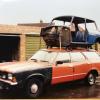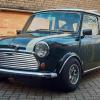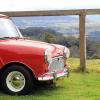I have also done the trigonometry session.... The formula I came up with I believe is correct up to the errors you put into it.
Used variables:
Piston dish (V_dish) [cc]
Combustion volume (V_head) [cc]
Gasket volume (V_gasket) [cc]
Ringland volume (V_ring) [cc]
Deck height (h_deck) [thou]
Bore diameter (d_bore) [mm]
Stroke (L_stroke) [mm]
Con rod length (L_conrod) [mm]
Intake valve closing, ABDC (alpha_int) [deg]
Formulas:
Lost stroke length (L_lost) = SQRT(L_conrod²-(0.5*L_stroke*sin(alpha_int*pi/180)*(0.5*L_stroke*sin(alpha_int*pi/180)))-0.5*L_stroke*because(alpha*pi/180)-(L_conrod-L_stroke/2)
Theoretical compression volume (V_theory) = pi*d_bore²*(1/4)*L_stroke/1000
Real compression volume (V_real) = pi*d_bore²*(1/4)*(L_stroke-L_lost)/1000
Unswept volume (V_static) = V_dish+((h_deck*25.4/1000)*pi*d_bore²/4)/1000+V_ring+V_gasket+V_head
Theoretical CR (CR_stat) = (V_theory+V_static)/V_static
Dynamic CR (CR_dyn) = (V_real+V_static)/V_static
Hope it is of use for someone.....


















